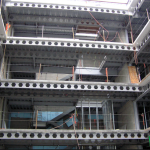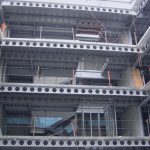Why use Castellated Beams?
Understanding the full selection of beams and girders you have access to is essential for your next construction job. There have been a number of technological advancements in the kinds of beams manufactured in recent years, making it possible to boost structural integrity to make it easier to feed servicing directly through the beams. One beam you will want to consider is the castellated beam. These beams have been around since the 1950s, although usage was focused primarily in Europe and, since then, other forms of beams have picked up in popularity. However, what often is old is new again, and that is exactly the case with castellated beams. Why use castellated beams? Here is what you need to know.
What Exactly Is a Castellated Beam?
A castellated beam is a rolled steel beam that has an expanded section that allows a predetermined hexagonal pattern to be cut directly on the webs of the beam. The rolled section of the beam is then cut into two individual halves.
The two halves are then offset and welded together right at the high point of the web pattern. This joining of the two halves at the web pattern is referred to as a “castellated or expanded open” beam. These kinds of beams were widely used throughout Europe in the 1950s, although this was mostly due to the overall lack of steel rolled sections. At this point, much of Europe was still rebuilding following the Second World War, so widespread access to steel (as well as affordable labor) was an issue. So in order to help stretch the amount of available steel and reduce overall , manufacturers took what rolled sections they had, split the sections in two, and then rolled the sections out utilizing the least amount of steel whereby producing a 30% to 40% stronger beam.
When Is Castellated Beams Needed?
Europe originally used the castellated beams because it had to. The lack of quality steel readily available gave construction teams very little choice in the matter. But the lack of rolled steel is no longer an issue in the United States, so why would a construction firm want to use the material?
Castellated beam geometric properties are typically thinner than standard steel rolled beams, yet the steel has not been compromised. Thick steel rolled beams can handle a considerable amount of weight, and most buildings do not put anywhere near the maximum weight on these beams. This means it is possible to use a lighter, thinner weight in the construction without reducing the integrity of the building. The lighter, thinner beams are less expensive and use less material, which can help save the construction money and are generally stronger than the equivalent wide slange section due to increased depth.
The high strength to weight ratio of castellated beams is both cost-effective and durable at the same time. So why use castellated beams? When a construction company wants to save money without putting the building at risk.
Why Use Castellated Beams?
There is already the cost savings potential regarding castellated beams. However, there are more instances when the beams should be utilized. This is especially the case when metal beams are needed for areas higher up within construction, such as the roof. When fabricating a roof, using heavier metal beams or large trusses is not desirable. The added weight may cause unnecessary problems with the roof itself, not to mention this kind of weight is not necessary. Instead, using a thinner, lighter metal beam, such as castellated beams, will provide superior support within the roof at a fraction of the weight of traditional wide flange construction.
Castellated beams are especially durable and can be altered easily. There may be times where a tapered beam is needed. Cutting a traditionally rolled steel beam can prove difficult, yet thanks to the cutting pattern already present within the castellated beam it is far easier to perform this tapered cut. The initially cut tapered beam can then be used as a guide for all other tapered cuts. This way, all of the cut castellated beams will be identical in the cut angle. The ability to perform tapered cuts easily with castellated beams allow for additional architectural options, as tapered cuts can then be joined together, giving a wider, stronger base, and a tapered, more slender top.
Durable and Affordable Beams
It doesn’t matter if a building is set to have two floors or two hundred floors, a number of steel beam options will likely be needed. However, not all of these beams need to be the complete rolled steel option. Whether used as the primary support beams or secondary support beams, it is not always necessary to use the thick, solid beams. Castellated beams make it possible to cut down on production costs without affecting the integrity of the building. It also allows for additional aesthetic opportunities. Whether using the tapered cut design or simply using the full castellated beam design as its own unique aesthetic during the construction of an exposed ceiling frame, there are plenty of reasons why you should consider integrating castellated beams into your next construction.
While initially designed out of necessity, these beams have proven to be especially desirable, which is why the popularity of these beams has only increased in recent years. If you have not yet started to use castellated beams in your own constructions now may be the time to consider adopting and utilizing the cost-effective beams. You may be surprised as to how much it might end up saving you in the long run in addition to the new kinds of design shapes you are able to add to your projects. Depending on the kind of constructions you fabricate, you may end up never using anything other than castellated beams moving forward.
Handling All Your Construction Beam Needs
Whether you’re looking for cellular beams, castellated beams, or another form of a beam, you need to work with a manufacturer that can handle your specific workload and order requirements. That is exactly what you get when turning to the team at C-Beams. So, whether you have further questions regarding the use of castellated beams or you want to know which particular beam might work best for your construction, the service staff at C-Beams is just a single phone call away.






